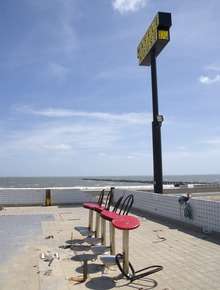Waffle House Index

The Waffle House Index is an informal metric used by the Federal Emergency Management Agency (FEMA) to determine the effect of a storm and the likely scale of assistance required for disaster recovery.[1]
If you get there and the Waffle House is closed? That's really bad... That's where you go to work.[2]
Levels
The index has three levels, based on the extent of operations and service at the restaurant following a storm:[2][3]
- GREEN: full menu - restaurant has power and damage is limited or no damage at all.
- YELLOW: limited menu - no power or only power from a generator, or food supplies may be low.
- RED: the restaurant is closed - indicating severe damage or severe flooding
Background
The term was coined by FEMA Administrator Craig Fugate in May 2011, following the 2011 Joplin tornado, during which the two Waffle House restaurants in Joplin remained open.[4][5]
The measure is based on the reputation of the restaurant chain Waffle House for staying open during extreme weather and for reopening quickly, albeit sometimes with a limited menu, after very severe weather events such as tornadoes or hurricanes. Waffle House, along with other chains (such as Home Depot, Walmart, and Lowe's) which do a significant proportion of their business in the southern US where there is a frequent risk of hurricanes, have good risk management and disaster preparedness. Because of this, and a cut-down menu prepared for times when there is no power or limited supplies, the Waffle House Index rarely reaches the red level.[2][4]
The Waffle House Index sits alongside more formal measures of wind, rainfall, and other weather information, such as the Saffir–Simpson Hurricane Scale, which are used to indicate the intensity of a storm.[2]
Dan Stoneking, FEMA director of external affairs, wrote in a FEMA blog post:[6][7]
As Craig [Fugate] often says, the Waffle House test doesn’t just tell us how quickly a business might rebound – it also tells us how the larger community is faring. The sooner restaurants, grocery and corner stores, or banks can re-open, the sooner local economies will start generating revenue again – signaling a stronger recovery for that community. The success of the private sector in preparing for and weathering disasters is essential to a community’s ability to recover in the long run.
— Dan Stoneking, FEMA News of the Day – What do Waffle Houses Have to Do with Risk Management?
Example
On Thursday October 6, 2016, the index reached red when all Waffle House restaurants on Florida's I-95 between Titusville and Fort Pierce were closed. This index change was caused by Hurricane Matthew ravaging Caribbean islands and the east coast of the United States.[8] The index once again reached red in October 2018, when 30 restaurants on the Florida Panhandle were closed ahead of Hurricane Michael.[9]
See also
References
- ↑ McKenna, Maryn (6 December 2016). "If Waffle House Is Closed, It's Time To Panic". FiveThirtyEight. Retrieved 14 December 2016.
- 1 2 3 4 Bauerlein, Valerie (September 1, 2011). "How to Measure a Storm's Fury One Breakfast at a Time". The Wall Street Journal.
- ↑ "Wait Wait... Don't Tell Me!: Craig Fugate". National Public Radio. May 28, 2016.
- 1 2 "What Do Waffles Have to Do with Risk Management?". EHS Today. July 6, 2011.
- ↑ "What the Waffle House Can Teach About Managing Supply Chain Risk". Insurance Journal. July 19, 2011.
- ↑ "News of the Day – What do Waffle Houses Have to Do with Risk Management? | FEMA.gov". www.fema.gov. Retrieved 2018-09-12.
- ↑ Judkis, Maura (September 12, 2018). "Hurricane Florence is a serious threat — just ask the Waffle House storm center". Washington Post. Retrieved 2018-09-12.
- ↑ Helsel, Phil (6 October 2016). "Waffle Houses Close in Florida, in Bad 'Index' Omen". NBC News (Waffle House Index reaches red). Retrieved 7 October 2016.
- ↑ "Hurricane Michael is so bad that Waffle House has closed 30 restaurants". USA Today. 11 October 2018. Retrieved 11 October 2018.
External links
- FEMA Blog: News of the Day (July 7, 2011) – What do Waffle Houses Have to Do with Risk Management?
- Always Open | Georgia Tech Alumni Magazine
- Colbert Report segment on FEMA's Waffle House Index
- Data Crunch episode on the Waffle House Index